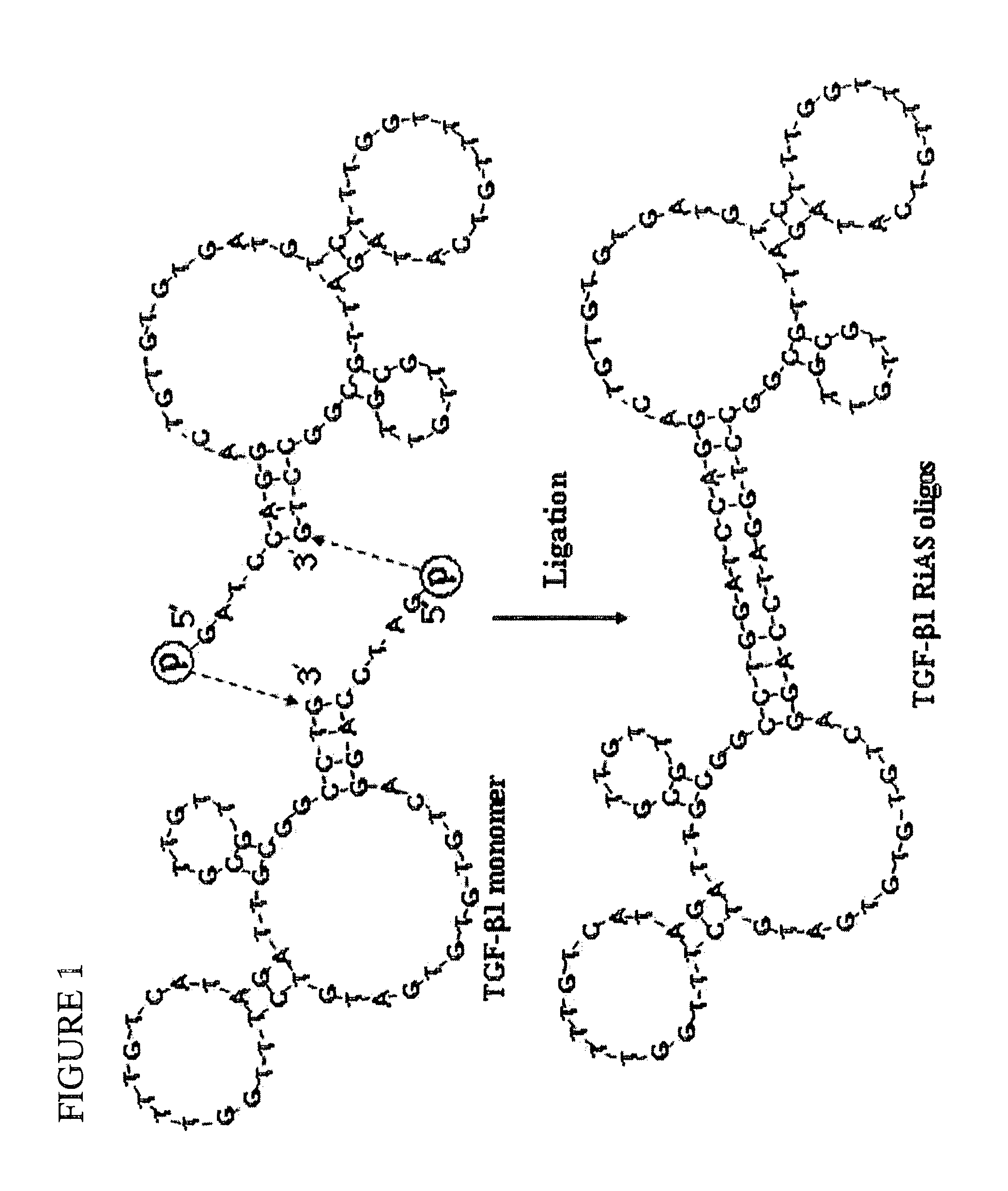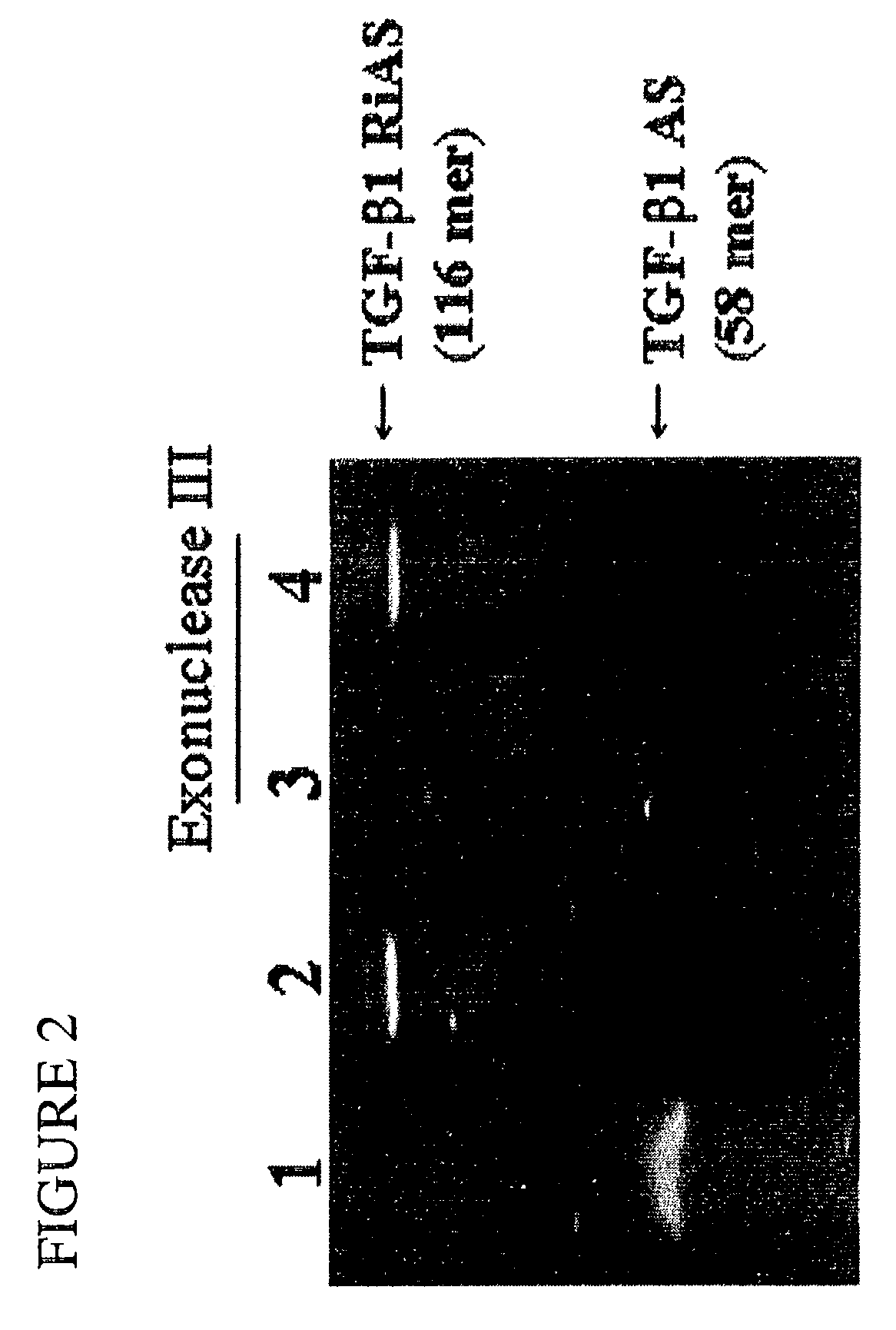TGF-beta-specific covalently closed antisense molecule
a covalently closed, antisense molecule technology, applied in the field of biotechnology, can solve the problems of sequence nonspecificity, instability to nuclease, use of oligos, etc., and achieve the effects of preventing fibrosis and tissue damage, preserving tissue integrity, and improving cellular uptak
- Summary
- Abstract
- Description
- Claims
- Application Information
AI Technical Summary
Benefits of technology
Problems solved by technology
Method used
Image
Examples
example 1
Cell Line and Animals
[0087]Rat hepatoma cell line, H4-IIE was obtained from American Type Culture Collection and maintained in EMEM medium containing 10% heat-inactivated fetal bovine serum (JBI, Daegu, Korea) and penicillin (100 U / ml) / streptomycin (100 μg / ml) in a humidified 5% CO2 incubator at 37° C.
[0088]Male Sprague-Dawley (SD) rats were supplied from SLC (Hamamatsu, Shizuoka, Japan). Animals were housed in groups of 6 with free access to standard chow and water. Male SD rats, weighing 200-250 g, were used in these experiments. After anesthesia by the intraperitoneal injection of pentobarbital (5 mg / 100 g body weight), the left kidney was exposed via an abdominal midline incision. Rats were subjected to ureteral ligation proximal to the left kidney, which was followed by a retrograde injection of TGF-β1 RiAS or control oligos using a 24-gauge catheter syringe.
example 2
Construction of Rat TGF-β1 RiAS
[0089]Oligos were synthesized using an automated DNA synthesizer Expedite™8909 (Applied Biosystems, Foster City, Calif.). Target sites for AS oligos were selected by sequential overlapping simulation of secondary structures using the DNAsis program (Hitachi Software, San Bruno, Calif.) (Matsuda et al., Mol. Biol. Cell 7, 1095-1106(1996)). Antisense sequences to TGF-β1 and sequences of scrambled oligos are as follows: antisense sequence: 5′-GAT CCA GGA CTG TGT GTG ATG TCT TTG GTT TTG TCA TAG ATT GCG TTG TTG CGG CCT G-3′ (SEQ ID NO:1), and scrambled sequence: 5′-GAT CCG CTG TCG TGC TGG TCT TGA GTT AAT TCG TTG TTG TTG TCT GAG TTG GTA TGC G-3′ (SEQ ID NO:2). See Table 1.
[0090]
TABLE 1Sequence of ribbon-type antisense oligos derived from TGF-β1 sequence.Complementary siteSizein TGF-β1 sequence(mer)Antisense sequence*TGF-β1757-80258GATCCAGGACTGTGTGTGATGTCTTTGGRiASTTTTGTCATAGATTGCGTTGTTGCGGCCTG (SEQ ID NO:1)ScrambledNon-specific58GATCCGCTGTCGTGCTGGTCTTGAGTTARi...
example 3
Transfection of RiAS by Liposome / Tat Peptide Complex
[0092]Four micrograms of DOTAP / DOPE (Avanti, Alabaster, Ala.) in 100 μl Opti-MEM (GibcoBRL, Rockville, Md.) were added to a tube containing Opti-MEM suspension, tat peptide and the antisense oligos. The mixture was incubated for 10 min. Ten thousand cells in each well of a 96-well plate were treated with the triple complex of oligos-tat-liposomes in 100 μl volume. Antisense oligos were used in the amount of either 0.1 or 0.3 μg. H4-IIE cells were incubated in a 5% CO2 incubator at 37° C. for 5 hr. Cells were then added with 100 μl of Opti-MEM with 20% FBS, and further incubated at 37° C. for 16 h before assay.
PUM
| Property | Measurement | Unit |
|---|---|---|
| molecular weights | aaaaa | aaaaa |
| molecular weights | aaaaa | aaaaa |
| volume | aaaaa | aaaaa |
Abstract
Description
Claims
Application Information
 Login to View More
Login to View More - R&D
- Intellectual Property
- Life Sciences
- Materials
- Tech Scout
- Unparalleled Data Quality
- Higher Quality Content
- 60% Fewer Hallucinations
Browse by: Latest US Patents, China's latest patents, Technical Efficacy Thesaurus, Application Domain, Technology Topic, Popular Technical Reports.
© 2025 PatSnap. All rights reserved.Legal|Privacy policy|Modern Slavery Act Transparency Statement|Sitemap|About US| Contact US: help@patsnap.com



